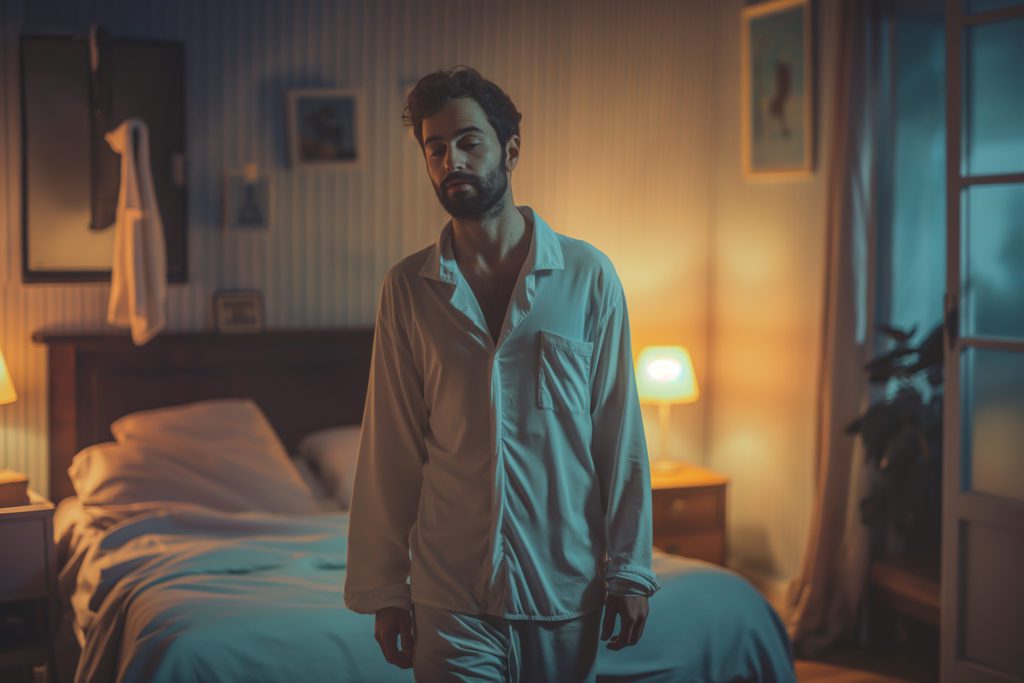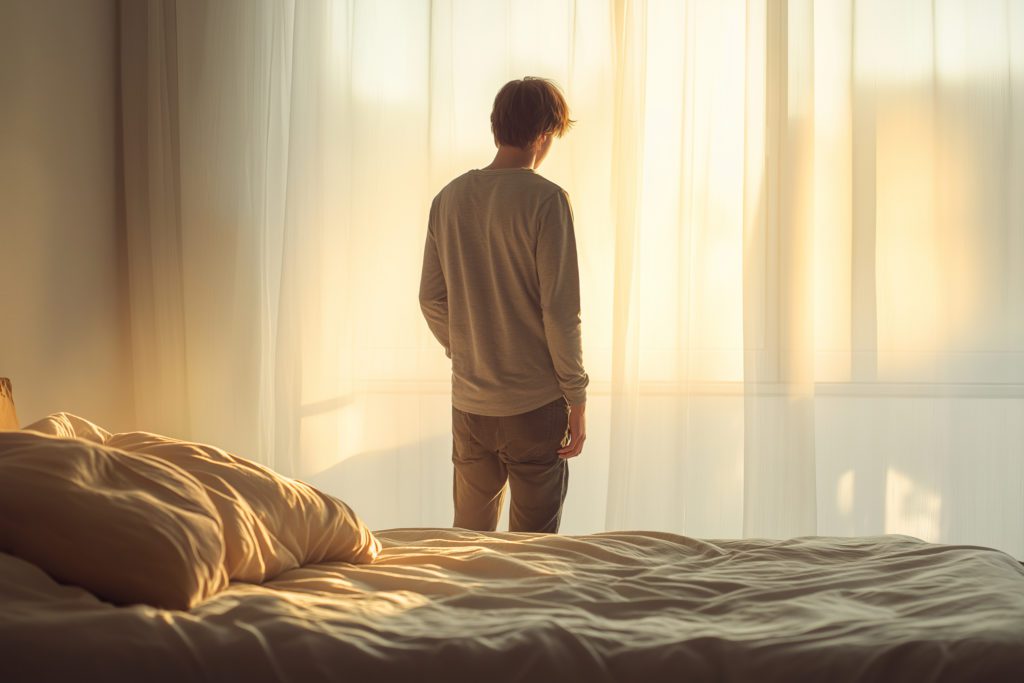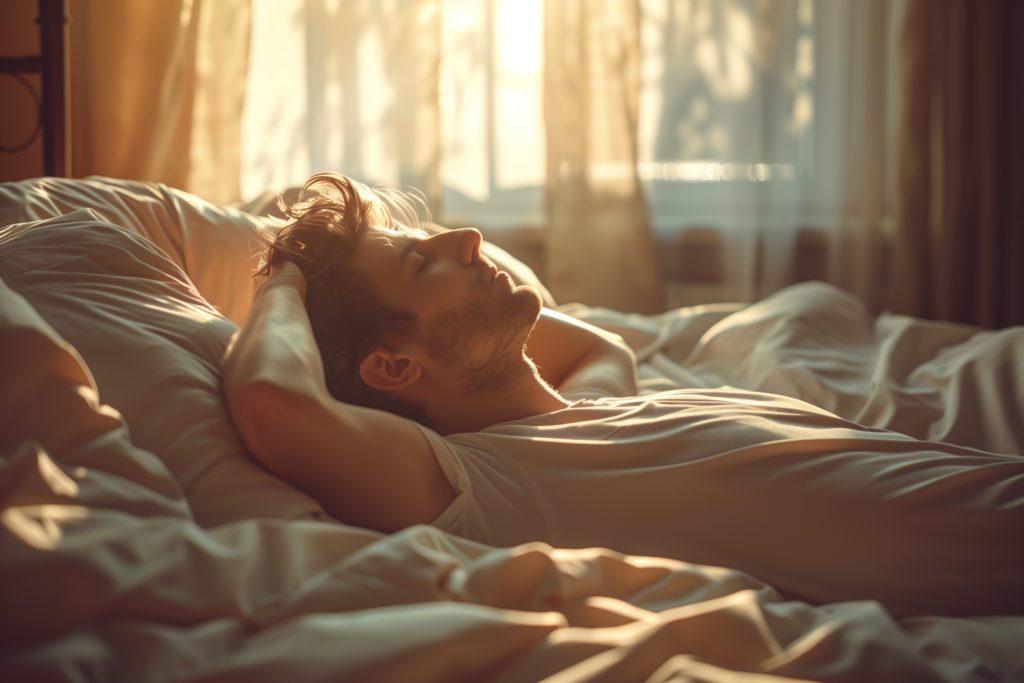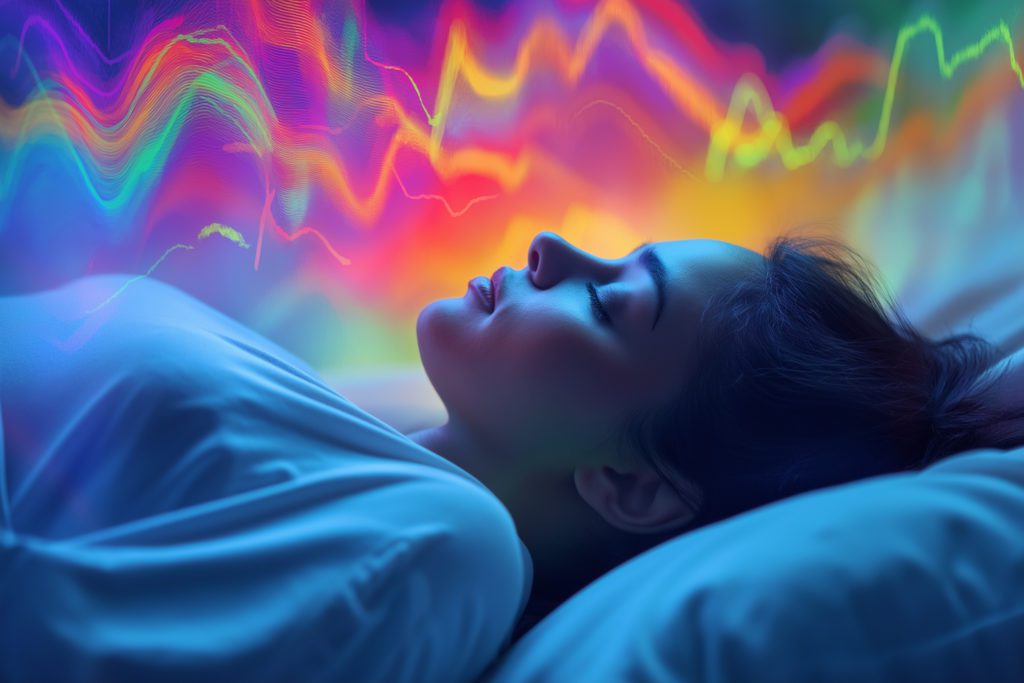
Why Do People Sleepwalk?
We explore the causes and symptoms of sleepwalking and offer some practical solutions to those affected.
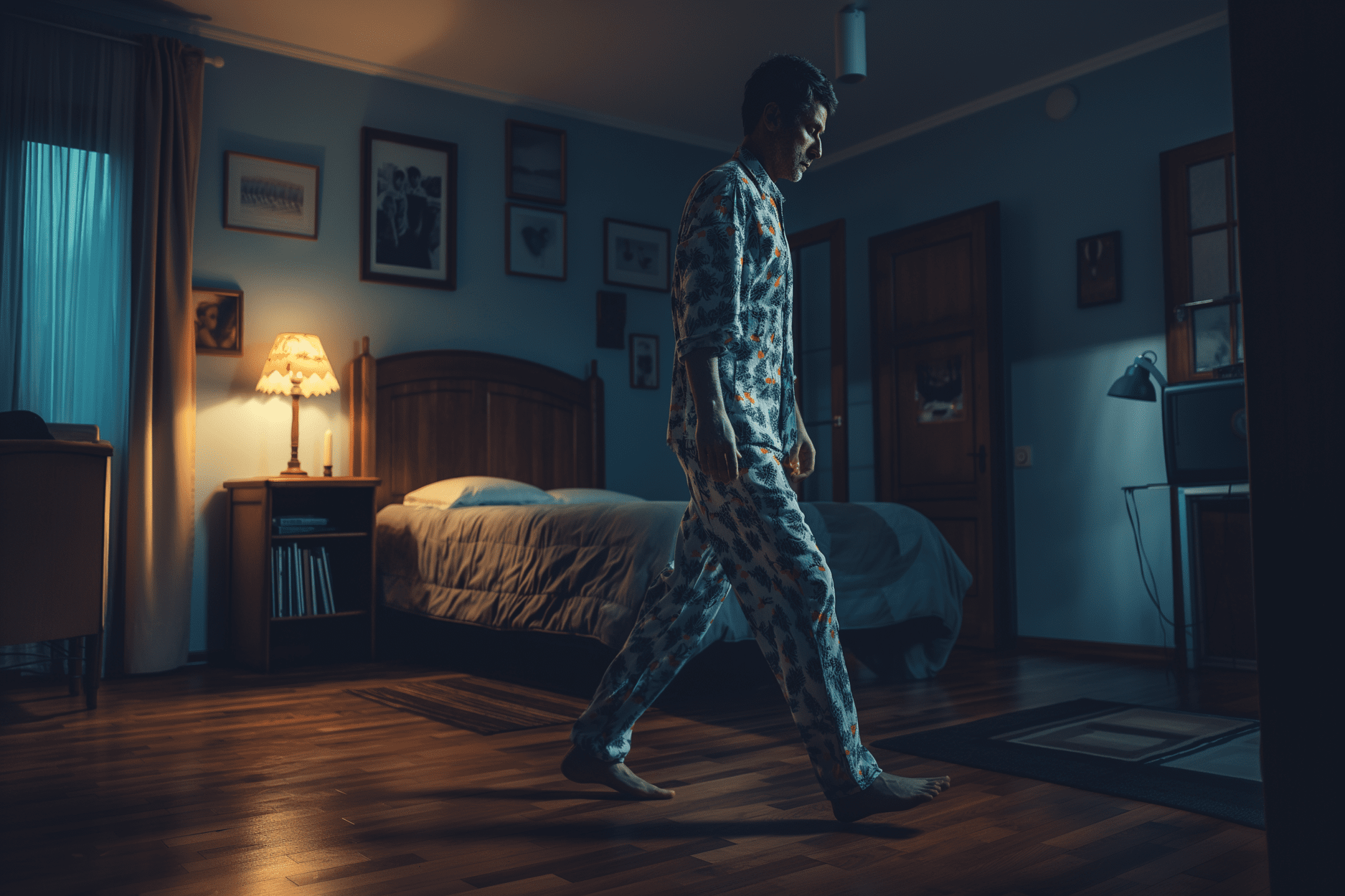
Sleepwalking is where somebody engages in a complex activity, such as walking, while they’re in a deep state of sleep. Not only can sleepwalking be concerning and confusing for the asleep person and anyone near them—it can be disconcerting, and also potentially dangerous.
In this article, we’ll explore some of the reasons why people sleepwalk, sleepwalking symptoms and causes, along with some insights into how to stop sleepwalking if you’re affected.
What Happens During Sleepwalking?
Sleepwalking is often referred to as “somnambulism”, which is originally a French word combining the Latin words for ‘sleep’ (somnus) and ‘to walk’ (ambulare).
This complex behavior falls within the category of sleep disorders, and involves individuals carrying out motor acts that are usually performed during a state of full consciousness—but while they’re in a deep sleep. While the name describes walking while sleeping, sleepwalking can easily involve other activities including:
- Talking
- Eating
- Cleaning
- Sending emails
- Getting dressed
Worryingly, in extreme cases, sleepwalkers may even engage in more dangerous or, let’s say, unwise activities while asleep, such as:
- Leaving the house
- Driving a vehicle
- Sexual activity
- Cooking
- Falling down stairs
- Jumping out of windows
Sleepwalking episodes occur during deep sleep, specifically non-REM sleep, so the sleepwalker has no idea what they’re doing. If woken up or roused during a sleepwalking episode, individuals are likely to be confused and extremely disoriented, and may even become violent.
The Science Behind Sleepwalking
The nuts and bolts of sleepwalking lie within the four sleep stages, which humans pass through during sleep. During the deep sleep stages, or non-REM sleep, the brain's activity is slightly different from its activity during REM sleep, which allows sleepwalking to be possible.
The non-REM stage is when your body is supposed to be at complete rest—and yet for sleepwalkers, it can lead to unexpected activity. This paradox raises questions about how the brain functions—what is it causing to merge sleep and wakefulness at the same time.
Some scientists have speculated that sleepwalking is caused by the brain attempting to directly transition from deep non-REM sleep to wakefulness, rather than going through the later stages of the sleep cycle.
There is likely to be a genetic link, with researchers finding the condition can be inherited. If one parent has a history of sleepwalking, their child has a 47% chance of also doing it. That rises to 62% if both parents have a history of sleepwalking.
Causes of Sleepwalking
There are a number of possible causes for sleepwalking, many of them linked to interruptions in the non-REM sleep phase. These may be a result of:
- Alcohol consumption: Drinking alcohol in the evenings can lead to the sleep stages becoming unstable, increasing the risk of sleepwalking
- Obstructive sleep apnea (OSA): This sleep disorder causes the airway to get blocked, which causes short lapses in breathing during sleep. This may create interruptions which could lead to sleepwalking
- Restless leg syndrome (RLS): This disorder gives the sleeping person a powerful urge to move their limbs, which may cause them to enter a sleepwalking episode
- Fever: Because having a fever may mean the sleeper is roused during the deep sleep phase, this may lead to them sleepwalking. This is particularly true for children
Other factors may include:
- Lack of sleep: If the individual is sleep deprived, they may spend more time in deep sleep, which could result in a sleepwalking episode
- Sedatives: Medications that have a sedative effect, such as Mirtazapine and Zolpidem, may lead to a quality of sleep that leads to sleepwalking
- Brain injury: Traumatic brain injury can lead to sleep disorders including sleepwalking
- Stress: This can lead to an interrupted, disturbed sleep which could increase the likelihood of sleepwalking
Sleepwalking Symptoms
Identifying the symptoms of sleepwalking can be challenging, since they often occur during deep sleep—meaning the person affected has no memory whatsoever of the event.
Any awake person who encounters the sleepwalker, of course, will be in a more suitable state to recognize symptoms. The following are common:
- Appearance of being awake
- Eyes open
- Blank facial expression
- Unresponsiveness to communication
- No memory of the sleepwalking episode
If you’re affected by sleepwalking, understanding these symptoms is crucial for being able to recognize the condition in your family and loved ones, and to ensure the safety of the sleepwalker and other people living under the same roof.
What to Do About Sleepwalking
When it comes to addressing sleepwalking, it’s advisable to take a multifaceted approach, firstly by eliminating known triggers. What this entails in each particular case will be different—the alcohol-drinking sleepwalker will want to try stopping consumption earlier, while the sleep-deprived sleep-walker may try getting more rest.
Establishing a consistent sleep schedule is advisable for anybody experiencing sleep disorder such as sleepwalking. This may involve avoiding daytime naps, reducing caffeine consumption, and avoiding watching TV/going on the Internet just before bed.
Relaxing techniques such as deep breathing, yoga, and meditation can also be useful in aiding a sounder sleep. Apps like Pillow can offer valuable insights into sleep patterns and potential triggers for individual episodes.
Some sleepwalkers have had success using a technique called anticipatory awakening, where a gentle wake-up call is scheduled just before the period of sleep where a sleepwalking episode is likely to occur. This can have the effect of resetting the sleep cycles and avoiding sleepwalking episodes.
A safe environment
Lastly, if there’s a sleepwalker in your household, it’s crucial to create a safe and secure environment where the affected person cannot endanger themself or others. This may include:
- Lock all doors and windows
- Remove obstacles from the floor
- Cover sharp corners to avoid injury risk
- Install safety gates at the top of stairs
Sleepwalking, or somnambulism, presents a fascinating yet complex challenge that intertwines deep sleep stages with involuntary physical activities. Understanding the symptoms, underlying causes, and effective prevention strategies is crucial for those affected by this condition.
By adopting a comprehensive approach that includes lifestyle adjustments, environmental safety measures, and possibly medical intervention, individuals can mitigate the risks associated with sleepwalking.
Moreover, fostering a supportive environment for sleepwalkers not only enhances their safety but also contributes to a better understanding and management of this intriguing sleep disorder.
Whether through minimizing known triggers, employing relaxation techniques, or utilizing technology like Pillow to monitor sleep patterns, the journey towards mitigating sleepwalking episodes is a proactive one. It underscores the importance of sleep hygiene and the need for personalized strategies to ensure the safety and well-being of sleepwalkers and their families.
FAQ
Is sleepwalking hereditary?
Yes, sleepwalking has a genetic component. Studies show that if one parent has a history of sleepwalking, their child has a 47% chance of experiencing it. If both parents sleepwalked, the likelihood increases to about 62%. This genetic predisposition highlights the role of heredity, though environmental and lifestyle factors also play a role.
Does sleepwalking indicate a serious health issue?
Sleepwalking itself isn’t typically dangerous but may signal underlying health concerns if episodes are frequent or severe. Conditions like obstructive sleep apnea, brain injuries, or high stress levels can contribute. In such cases, medical evaluation is crucial to identify and treat the root cause effectively.
Can sleepwalking be dangerous?
Yes, sleepwalking poses safety risks as individuals may injure themselves by falling, walking into objects, or performing hazardous tasks like cooking or driving. Creating a safe sleep environment, such as removing sharp objects or locking doors, is essential to minimizing the risks associated with sleepwalking episodes.
How does sleepwalking differ from other sleep disorders?
Sleepwalking occurs during non-REM sleep, often in the deepest stages. This differs from disorders like REM behavior disorder, where individuals act out dreams during REM sleep. Unlike sleepwalkers, people with REM behavior disorder are more likely to recall their actions after waking, as they occur during lighter sleep phases.
Is there a cure for sleepwalking?
There’s no universal cure, but managing triggers and improving sleep habits can help reduce episodes. Addressing underlying conditions like sleep apnea or stress is also important. In severe cases, treatments such as cognitive behavioral therapy, medication, or lifestyle adjustments may be recommended by healthcare professionals.
Why does sleepwalking occur during non-REM sleep?
Sleepwalking arises during non-REM sleep because this stage involves deep sleep, when the brain is less responsive but capable of partial arousal. If the brain transitions imperfectly between deep sleep and wakefulness, motor functions may activate while consciousness remains subdued. This phenomenon explains why actions occur without memory.
Can sleepwalking episodes last a long time?
Sleepwalking episodes are usually brief, lasting just a few minutes. However, they can sometimes extend up to 30 minutes or more, depending on factors like the individual’s sleep stage, stress levels, or external disturbances. While rare, prolonged episodes may involve more complex activities, increasing potential safety risks.
Is it possible to remember sleepwalking episodes?
Most sleepwalkers do not recall their episodes because the brain remains in a deep, non-REM sleep state during the activity. This disconnect between brain regions suppresses memory formation. In rare cases, a person might have a vague or fragmented recollection, often influenced by external interventions like being awakened mid-episode.

Written by
Georgia Austin
Professionally trained copywriter, editor, and content marketing strategist with over 7 years of experience—working with brands like Nike, Siemens, Toshiba, Tommy Hilfiger, Culture Trip, and Klook.
Download Pillow
Get help
Press & News
Legal
Connect
X (Twitter)
Company
Copyright © Neybox Digital Ltd.
